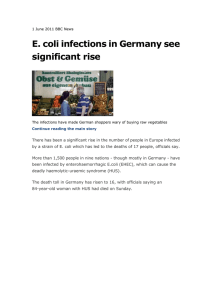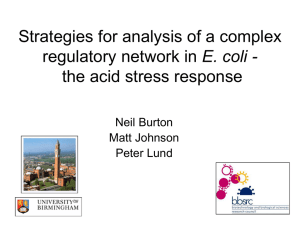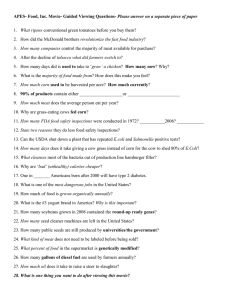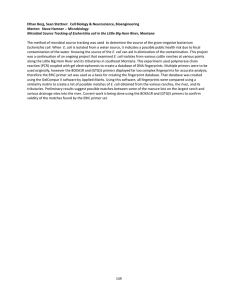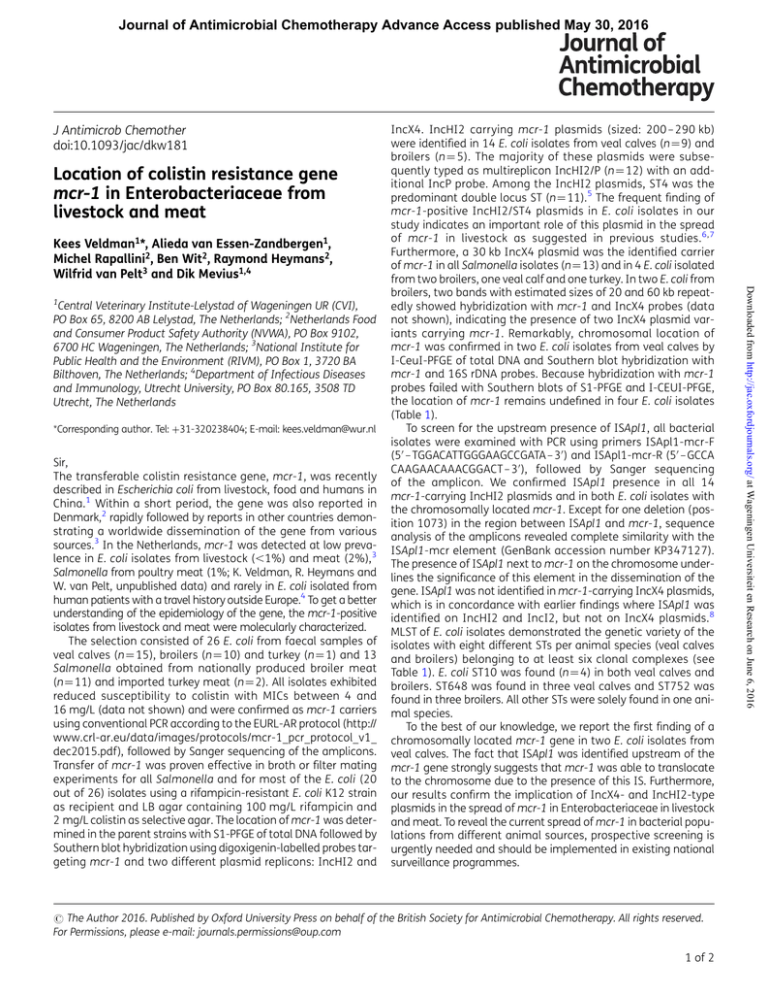
Journal of Antimicrobial Chemotherapy Advance Access published May 30, 2016
J Antimicrob Chemother
doi:10.1093/jac/dkw181
Location of colistin resistance gene
mcr-1 in Enterobacteriaceae from
livestock and meat
Kees Veldman1*, Alieda van Essen-Zandbergen1,
Michel Rapallini2, Ben Wit2, Raymond Heymans2,
Wilfrid van Pelt3 and Dik Mevius1,4
Central Veterinary Institute-Lelystad of Wageningen UR (CVI),
PO Box 65, 8200 AB Lelystad, The Netherlands; 2Netherlands Food
and Consumer Product Safety Authority (NVWA), PO Box 9102,
6700 HC Wageningen, The Netherlands; 3National Institute for
Public Health and the Environment (RIVM), PO Box 1, 3720 BA
Bilthoven, The Netherlands; 4Department of Infectious Diseases
and Immunology, Utrecht University, PO Box 80.165, 3508 TD
Utrecht, The Netherlands
*Corresponding author. Tel: +31-320238404; E-mail: kees.veldman@wur.nl
Sir,
The transferable colistin resistance gene, mcr-1, was recently
described in Escherichia coli from livestock, food and humans in
China.1 Within a short period, the gene was also reported in
Denmark,2 rapidly followed by reports in other countries demonstrating a worldwide dissemination of the gene from various
sources.3 In the Netherlands, mcr-1 was detected at low prevalence in E. coli isolates from livestock (,1%) and meat (2%),3
Salmonella from poultry meat (1%; K. Veldman, R. Heymans and
W. van Pelt, unpublished data) and rarely in E. coli isolated from
human patients with a travel history outside Europe.4 To get a better
understanding of the epidemiology of the gene, the mcr-1-positive
isolates from livestock and meat were molecularly characterized.
The selection consisted of 26 E. coli from faecal samples of
veal calves (n ¼ 15), broilers (n ¼ 10) and turkey (n ¼ 1) and 13
Salmonella obtained from nationally produced broiler meat
(n ¼ 11) and imported turkey meat (n ¼ 2). All isolates exhibited
reduced susceptibility to colistin with MICs between 4 and
16 mg/L (data not shown) and were confirmed as mcr-1 carriers
using conventional PCR according to the EURL-AR protocol (http://
www.crl-ar.eu/data/images/protocols/mcr-1_pcr_protocol_v1_
dec2015.pdf), followed by Sanger sequencing of the amplicons.
Transfer of mcr-1 was proven effective in broth or filter mating
experiments for all Salmonella and for most of the E. coli (20
out of 26) isolates using a rifampicin-resistant E. coli K12 strain
as recipient and LB agar containing 100 mg/L rifampicin and
2 mg/L colistin as selective agar. The location of mcr-1 was determined in the parent strains with S1-PFGE of total DNA followed by
Southern blot hybridization using digoxigenin-labelled probes targeting mcr-1 and two different plasmid replicons: IncHI2 and
# The Author 2016. Published by Oxford University Press on behalf of the British Society for Antimicrobial Chemotherapy. All rights reserved.
For Permissions, please e-mail: journals.permissions@oup.com
1 of 2
Downloaded from http://jac.oxfordjournals.org/ at Wageningen Universiteit en Research on June 6, 2016
1
IncX4. IncHI2 carrying mcr-1 plasmids (sized: 200 – 290 kb)
were identified in 14 E. coli isolates from veal calves (n ¼ 9) and
broilers (n ¼ 5). The majority of these plasmids were subsequently typed as multireplicon IncHI2/P (n ¼ 12) with an additional IncP probe. Among the IncHI2 plasmids, ST4 was the
predominant double locus ST (n ¼ 11).5 The frequent finding of
mcr-1-positive IncHI2/ST4 plasmids in E. coli isolates in our
study indicates an important role of this plasmid in the spread
of mcr-1 in livestock as suggested in previous studies. 6,7
Furthermore, a 30 kb IncX4 plasmid was the identified carrier
of mcr-1 in all Salmonella isolates (n ¼ 13) and in 4 E. coli isolated
from two broilers, one veal calf and one turkey. In two E. coli from
broilers, two bands with estimated sizes of 20 and 60 kb repeatedly showed hybridization with mcr-1 and IncX4 probes (data
not shown), indicating the presence of two IncX4 plasmid variants carrying mcr-1. Remarkably, chromosomal location of
mcr-1 was confirmed in two E. coli isolates from veal calves by
I-CeuI-PFGE of total DNA and Southern blot hybridization with
mcr-1 and 16S rDNA probes. Because hybridization with mcr-1
probes failed with Southern blots of S1-PFGE and I-CEUI-PFGE,
the location of mcr-1 remains undefined in four E. coli isolates
(Table 1).
To screen for the upstream presence of ISApl1, all bacterial
isolates were examined with PCR using primers ISApl1-mcr-F
(5′ – TGGACATTGGGAAGCCGATA – 3′ ) and ISApl1-mcr-R (5′ – GCCA
CAAGAACAAACGGACT – 3′ ), followed by Sanger sequencing
of the amplicon. We confirmed ISApl1 presence in all 14
mcr-1-carrying IncHI2 plasmids and in both E. coli isolates with
the chromosomally located mcr-1. Except for one deletion (position 1073) in the region between ISApl1 and mcr-1, sequence
analysis of the amplicons revealed complete similarity with the
ISApl1-mcr element (GenBank accession number KP347127).
The presence of ISApl1 next to mcr-1 on the chromosome underlines the significance of this element in the dissemination of the
gene. ISApl1 was not identified in mcr-1-carrying IncX4 plasmids,
which is in concordance with earlier findings where ISApl1 was
identified on IncHI2 and IncI2, but not on IncX4 plasmids.8
MLST of E. coli isolates demonstrated the genetic variety of the
isolates with eight different STs per animal species (veal calves
and broilers) belonging to at least six clonal complexes (see
Table 1). E. coli ST10 was found (n ¼ 4) in both veal calves and
broilers. ST648 was found in three veal calves and ST752 was
found in three broilers. All other STs were solely found in one animal species.
To the best of our knowledge, we report the first finding of a
chromosomally located mcr-1 gene in two E. coli isolates from
veal calves. The fact that ISApl1 was identified upstream of the
mcr-1 gene strongly suggests that mcr-1 was able to translocate
to the chromosome due to the presence of this IS. Furthermore,
our results confirm the implication of IncX4- and IncHI2-type
plasmids in the spread of mcr-1 in Enterobacteriaceae in livestock
and meat. To reveal the current spread of mcr-1 in bacterial populations from different animal sources, prospective screening is
urgently needed and should be implemented in existing national
surveillance programmes.
Research letter
Table 1. Characteristics of mcr-1-positive E. coli (n ¼26) and Salmonella (n ¼13) from livestock and meat
Species (n)
ISApl1
Source
Isolation
year
MLST ST(s) (n)
IncX4 (30 kb)
IncX4 (20+60 kb)
IncX4 (30 kb)
IncX4 (30 kb)
IncX4 (30 kb)
IncX4 (30 kb)
IncX4 (30 kb)
IncHI2/ST2 (200 kb)
IncHI2/ST4 (275 kb)
IncHI2/P/ST3 (290 kb)
IncHI2/P/ST4 (240– 275 kb)
IncHI2/P/ST4 (225– 245 kb)
IncHI2/P/ST6 (240 kb)
not defined
not defined
chromosomal
no
no
no
no
no
no
no
yes
yes
yes
yes
yes
yes
yes
yes
yes
broiler
broiler
turkey
veal calf
chicken meat
turkey meat
turkey meat
veal calf
veal calf
broiler
veal calf
broiler
broiler
veal calf
broiler
veal calf
2011 –13
2010 –13
2011
2010
2010 –15
2013
2015
2011
2010
2012
2010 –11
2012
2012
2011
2012
2010 –11
ST1730, ST4512
ST752 (2)
ST1564
ST57
NA
NA
NA
ST410
ST648
ST10
ST10, ST57, ST624, ST648 (2), ST1011, STnew
ST38, ST752, ST2309
ST351
ST10, ST410, ST648
ST10
ST57 (2)
NA, not applicable.
Acknowledgements
bloodstream infection and imported chicken meat, Denmark 2015. Euro
Surveill 2015; 20: pii¼30155.
Part of this work was presented at the Twenty-sixth European Congress
of Clinical Microbiology and Infectious Diseases, Amsterdam, The
Netherlands (Abstract no. 7430).
3 Skov RL, Monnet DL. Plasmid-mediated colistin resistance (mcr-1
gene): three months later, the story unfolds. Euro Surveill 2016; 21:
pii¼30085.
Funding
This study was supported by the Dutch Ministry of Economic Affairs (grant
number WOT-01-002-03.02).
Transparency declarations
None to declare.
References
1 Liu YY, Wang Y, Walsh TR et al. Emergence of plasmid-mediated colistin
resistance mechanism MCR-1 in animals and human beings in China: a
microbiological and molecular biological study. Lancet Infect Dis
2016; 16: 161–8.
2 Hasman H, Hammerum AM, Hansen F et al. Detection of mcr-1 encoding
plasmid-mediated colistin-resistant Escherichia coli isolates from human
2 of 2
4 Kluytmans-van den Bergh MF, Huizinga P, Bonten MJ et al. Presence
of mcr-1-positive Enterobacteriaceae in retail chicken meat but not
in humans in the Netherlands since 2009. Euro Surveill 2016; 21:
pii¼30149.
5 Garcia-Fernandez A, Carattoli A. Plasmid double locus sequence typing
for IncHI2 plasmids, a subtyping scheme for the characterization of
IncHI2 plasmids carrying extended-spectrum b-lactamase and quinolone
resistance genes. J Antimicrob Chemother 2010; 65: 1155 –61.
6 Haenni M, Poirel L, Kieffer N et al. Co-occurrence of extended spectrum b
lactamase and MCR-1 encoding genes on plasmids. Lancet Infect Dis
2016; 16: 281–2.
7 Grami R, Mansour W, Mehri W et al. Impact of food animal trade on the
spread of mcr-1-mediated colistin resistance, Tunisia, July 2015. Euro
Surveill 2016; 21: pii¼30144.
8 Falgenhauer L, Waezsada SE, Yao Y et al. Colistin resistance gene mcr-1
in extended-spectrum b-lactamase-producing and carbapenemaseproducing Gram-negative bacteria in Germany. Lancet Infect Dis
2016; 16: 282 – 3.
Downloaded from http://jac.oxfordjournals.org/ at Wageningen Universiteit en Research on June 6, 2016
E. coli (2)
E. coli (2)
E. coli (1)
E. coli (1)
Salmonella Java (11)
Salmonella Anatum (1)
Salmonella Schwartzengrund (1)
E. coli (1)
E. coli (1)
E. coli (1)
E. coli (7)
E. coli (3)
E. coli (1)
E. coli (3)
E. coli (1)
E. coli (2)
Location of mcr-1


